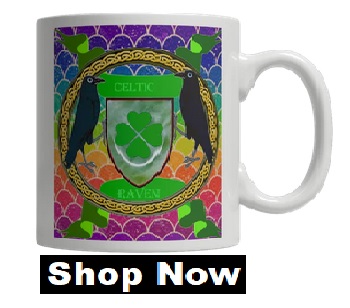Ravens on the Battlefield: Odin's Raven Warriors in Viking Warfare
In the fierce and tumultuous world of Viking warfare, where warriors clashed with unyielding valor, the raven soared as a revered symbol of divine favor and guidance. As the embodiment of Odin's mystical prowess, these ebony-winged birds played a captivating role on the battlefield, inspiring fear in their enemies and imbuing the Norse warriors with unwavering courage.
Odin's Raven Warriors: Harbingers of Victory
In the Norse pantheon, Odin stood as the All-Father, a god of war and wisdom. Among his many attributes, his connection to ravens was one of profound significance. Huginn and Muninn, named "Thought" and "Memory," soared as his winged companions, bringing him whispers of the world's secrets. On the battlefield, the sight of these ravens circling overhead was seen as a sign of Odin's presence, heralding divine favor and ensuring victory in the face of peril.
The Battle Cry of the Ravens
As Viking warriors charged into the fray, the haunting caws of the ravens echoed through the clash of swords and the roar of battle. This symphony of sound became a rallying cry, a potent reminder of the gods' watchful eyes and a signal of divine intervention. The Norsemen drew strength from the ravens' presence, believing that Odin himself guided their blades and shaped their fate.
Guides to Valhalla's Halls
In the Viking belief of the afterlife, fallen warriors who died bravely in battle were destined for Valhalla, the hall of heroes. It was the ravens' divine duty to guide these souls to the sacred halls, where they would feast and prepare for the apocalyptic battle of Ragnarok. This connection between the ravens and the afterlife gave the warriors solace, knowing that their brave deeds would be rewarded in the company of the gods.
Raven-Adorned Banners and Shields
To honor the enigmatic connection between Odin and ravens, Viking warriors adorned their banners and shields with raven symbols. These emblems of divine protection became talismans of courage and a testament to the bond between the warriors and the gods. The raven's presence on their weaponry bolstered their resolve, reminding them of the unseen forces that watched over them in the heat of battle.
Ravens: The Fear-Inducing Symbol
The ravens' mythic significance extended beyond their association with Odin; they also struck fear into the hearts of their enemies. To those who faced the Norsemen on the battlefield, the sight of the ravens circling overhead evoked a sense of foreboding, a sign that divine forces were aligned against them. The psychological impact of this fear became a powerful weapon, tipping the scales of battle in the Vikings' favor.
Legacy of Odin's Raven Warriors
Though the Viking Age has long passed into history, the legacy of Odin's raven warriors endures in the annals of time. Their role as messengers of the gods and guardians of the fallen heroes remains etched into the cultural fabric of the Norse. The image of Huginn and Muninn soaring through the pages of history is a testament to the unwavering faith the Vikings had in their gods and the mystical powers that shaped their destiny.
Embrace the Warrior Spirit
As we delve into the captivating realm of Odin's raven warriors, we honor the enduring legacy of Viking warfare and the mystic allure of Norse mythology. The ravens' presence on the battlefield was more than mere folklore; it was a testament to the unwavering courage and faith of the Norsemen. In their fearsome flight, we find an invitation to embrace the warrior spirit within ourselves, drawing strength from the enigmatic connection between mortals and gods.
Ravens on the Battlefield: Emblems of Divine Valor
In the realm of Viking warfare, ravens soared as harbingers of victory, embodying the mystical prowess of Odin himself. With each caw and flight, they inspired courage and fear in equal measure, tipping the scales of battle in the Vikings' favor. As symbols of divine guidance and protection, the ravens adorned banners and shields, a testament to the bond between warriors and gods. In their timeless legacy, we find an enduring invitation to embrace the warrior spirit within, drawing strength from the enigmatic connection between the mortal and the divine.
- Eyes of the Gods: The All-Seeing Ravens in Viking Mythology
- Feathered Prophets: Ravens as Harbingers of Fate in the Viking Age
- Odin's Messengers: The Sacred Significance of Ravens in Viking Beliefs
- Raven Banner: The Powerful Symbolism of Ravens in Viking Flags and Banners
- Ravenlore: Unraveling the Enigmatic Role of Ravens in Viking Folklore
- Ravens and Magic: Exploring the Shamanic Connection in Viking Culture
- Ravens of Valhalla: The Mythic Role of Ravens in Viking Culture
- Ravens on the Battlefield: Odin's Raven Warriors in Viking Warfare
- Viking Burial Rituals: Ravens as Guides to the Afterlife
- Viking Raven Tattoos: Embracing the Symbol of Wisdom and Power
Ravenlore: Unraveling the Enigmatic Role of Ravens in Viking Folklore
In the rich tapestry of Viking folklore, where myths and legends intertwine with the mysteries of the natural world, ravens emerge as enigmatic creatures of profound significance. Revered for their intelligence and keen perception, these ebony-winged birds play a captivating role in Viking culture, bridging the realms of mortals and gods.
Messengers of Odin: Heralds of Wisdom
Among the Norse gods, Odin stands as the All-Father, a figure of war and wisdom. His connection to ravens, Huginn, and Muninn, named "Thought" and "Memory," establishes them as his wise messengers. With each flight, they carry the whispers of the world's secrets back to Valhalla, where Odin seeks their counsel and weaves the threads of destiny. In their role as messengers, ravens embody the divine wisdom that shapes the course of the Viking world.
Symbols of Prophecy and Fate
In Viking folklore, ravens are seen as symbols of prophecy and fate. Their calls and movements were carefully observed, believed to carry messages from the gods. As the birds circled the skies or perched upon the battlefield, they brought with them omens of victory or impending danger. To the Vikings, the raven's presence held great significance, offering glimpses into the tapestry of fate and the unseen forces that shape mortal lives.
Guides to the Afterlife
In the Viking belief of the afterlife, the role of ravens extends to guiding fallen warriors to Valhalla. Brave warriors who died in battle were destined for the hallowed halls of this celestial realm. Huginn and Muninn, with their divine duty, guided the souls of the fallen heroes, ensuring their safe passage to the halls of eternal glory. This role as psychopomps underscores the ravens' connection to the cycle of life and death.
Ravens in Norse Art and Symbolism
The allure of ravens found expression in Viking art and symbolism. These majestic birds adorned jewelry, amulets, and runes, becoming cherished talismans of protection and wisdom. In Viking longships, the image of the raven graced the sails, symbolizing divine guidance and favor on their perilous journeys. The raven's image in art and craftsmanship spoke to the deep reverence the Norse held for these sacred birds and their connection to the divine.
The Raven's Dual Nature
In Norse folklore, ravens embody a duality that reflects the complexities of life. They are revered for their intelligence and insight, attributes that parallel human intellect and wisdom. Yet, they also represent cunning and adaptability, mirroring the survival instincts of Viking warriors and explorers who braved the harsh landscapes of the North. This dual nature makes them a fitting symbol for the intricacies of Viking beliefs.
The Timeless Allure of Ravenlore
Though the Viking Age has long passed, the allure of ravenlore continues to captivate the modern imagination. The enigmatic connection between ravens and the gods, their role as omens of fate, and their place in the afterlife still resonate today. As we explore the mysteries of Viking folklore, we find ourselves drawn into the realm of these wise and mysterious creatures, embracing the timeless allure of their presence in ancient myth and legend.
Embrace the Mystical Wisdom
As we unravel the enigmatic role of ravens in Viking folklore, we embrace the mystical wisdom they embody. From their status as messengers of the gods to their role as symbols of prophecy and fate, these birds leave an indelible mark on the cultural fabric of the North. In the allure of ravenlore, we find an invitation to explore the interconnectedness of the mortal and divine, drawing inspiration from the intelligence and insight of these sacred creatures.
Ravenlore: Unraveling the Mysteries of the Norse World
In the captivating realm of Viking folklore, ravens soar as enigmatic creatures of profound significance. As messengers of Odin, symbols of prophecy, and guides to the afterlife, they weave a tapestry of wisdom and mystery that transcends time. Their presence in art and symbolism speaks to the deep reverence the Norse held for these sacred birds. Today, as we explore the timeless allure of ravenlore, we honor the interconnectedness of the mortal and the divine, drawing inspiration from the intelligence and insight of these wise creatures.
- Eyes of the Gods: The All-Seeing Ravens in Viking Mythology
- Feathered Prophets: Ravens as Harbingers of Fate in the Viking Age
- Odin's Messengers: The Sacred Significance of Ravens in Viking Beliefs
- Raven Banner: The Powerful Symbolism of Ravens in Viking Flags and Banners
- Ravenlore: Unraveling the Enigmatic Role of Ravens in Viking Folklore
- Ravens and Magic: Exploring the Shamanic Connection in Viking Culture
- Ravens of Valhalla: The Mythic Role of Ravens in Viking Culture
- Ravens on the Battlefield: Odin's Raven Warriors in Viking Warfare
- Viking Burial Rituals: Ravens as Guides to the Afterlife
- Viking Raven Tattoos: Embracing the Symbol of Wisdom and Power
Ravens and Magic: Exploring the Shamanic Connection in Viking Culture
In the mystical realm of Viking culture, where the natural world and the supernatural intertwined, ravens emerged as envoys of magic and shamanic power. Revered for their keen intelligence and deep connection to the spiritual realm, these ebony-winged creatures played a captivating role in Viking shamanism, bridging the gap between mortals and the divine.
The Shamanic Path: Connecting Mortal and Divine Realms
Shamanism, a central aspect of Viking spirituality, allowed the practitioner, known as the shaman, to transcend the boundaries of the physical world and communicate with the spirits. With their remarkable intelligence and perception, ravens became vital companions in this shamanic journey, guiding the practitioner between realms and offering a glimpse into the unseen forces that shaped mortal existence.
Ravens as Spirit Guides
For the Viking shaman, ravens served as powerful spirit guides. These wise birds, with their uncanny ability to traverse the natural and supernatural worlds, offered their wisdom and insights to those who embarked on shamanic quests. As the shaman delved into the hidden realms, the ravens accompanied them, guarding against malevolent spirits and illuminating the path to esoteric knowledge.
Ravens as Messengers of the Gods
In the pantheon of Norse gods, Odin's connection to ravens imbued these creatures with divine significance. Odin, the god of wisdom and magic, was known to shape-shift into various forms, and one of his preferred guises was that of a raven. This link between Odin and ravens deepened their mystical association in Viking culture. As messengers of the gods, ravens brought divine revelations and sacred knowledge to the shaman during their trances and visions.
The Raven's Voice: Channeling the Unseen
In Viking shamanism, ravens served as conduits for channeling the voices of the spirits. Through the shaman's communion with the ravens, they accessed the hidden wisdom of the gods and the spirits of the ancestors. The raven's voice became a sacred language of esoteric knowledge, weaving the fabric of the unseen world into the tapestry of mortal existence.
Ravenlore in Rituals and Ceremonies
Ravens found a prominent place in Viking rituals and ceremonies. In sacred rites, their presence was invoked to invite the blessings of the gods and the guidance of ancestral spirits. Their ebony feathers were used in divination practices, providing insight into the future and the hidden mysteries of life. The shaman adorned themselves with raven symbols, embracing the wisdom and protection that these mystical creatures offered in their shamanic endeavors.
The Enigmatic Legacy of Ravens and Magic
The shamanic connection between ravens and magic continues to intrigue and inspire. The allure of these enigmatic creatures in Viking culture serves as a reminder of the enduring fascination humans have with the unseen and the mystical. As we explore the shamanic realm of the Vikings, we find ourselves drawn into the wisdom and power that ravens symbolized, honoring their sacred place in the tapestry of spiritual beliefs.
Embrace the Raven's Mystic Wisdom
As we delve into the mesmerizing world of ravens and magic in Viking culture, we embrace the mystic wisdom these creatures embody. In their shamanic role as spirit guides and messengers of the gods, they beckon us to explore the unseen realms and to seek wisdom from the divine. Today, the connection between ravens and shamanism offers an invitation to embrace the mystical allure of the natural world and to honor the timeless legacy of these wise and enigmatic creatures.
Ravens and Magic: The Shamanic Connection Unveiled
In the captivating realm of Viking culture, ravens soar as envoys of magic and shamanic power. As spirit guides and messengers of the gods, they weave a tapestry of wisdom and mystery that transcends time. In Viking shamanism, these wise birds serve as conduits for the unseen and sacred, offering insights into the hidden realms. As we explore their enigmatic legacy, we embrace the allure of the mystical and the enduring fascination humans have with the unseen forces that shape our world.
- Eyes of the Gods: The All-Seeing Ravens in Viking Mythology
- Feathered Prophets: Ravens as Harbingers of Fate in the Viking Age
- Odin's Messengers: The Sacred Significance of Ravens in Viking Beliefs
- Raven Banner: The Powerful Symbolism of Ravens in Viking Flags and Banners
- Ravenlore: Unraveling the Enigmatic Role of Ravens in Viking Folklore
- Ravens and Magic: Exploring the Shamanic Connection in Viking Culture
- Ravens of Valhalla: The Mythic Role of Ravens in Viking Culture
- Ravens on the Battlefield: Odin's Raven Warriors in Viking Warfare
- Viking Burial Rituals: Ravens as Guides to the Afterlife
- Viking Raven Tattoos: Embracing the Symbol of Wisdom and Power
Viking Burial Rituals: Ravens as Guides to the Afterlife
In the captivating world of Viking culture, where legends and myths intertwine with the mysteries of life and death, burial rituals held profound significance. Among the rituals that emerged from this enigmatic society, the presence of ravens as guides to the afterlife stands as a testament to the enduring allure of these wise and mystical creatures.
Honoring the Fallen: A Sacred Journey to Valhalla
In Viking beliefs, death was not the end but a sacred journey to the afterlife. Fallen warriors who died bravely in battle were destined for Valhalla, the hallowed hall where they would feast and prepare for the final apocalyptic battle of Ragnarok. In these burial rites, the ravens played an essential role as guides, leading the souls of the departed to this celestial realm of eternal glory.
Ravens: The Guardians of the Fallen Heroes
As the Norse people bid farewell to their fallen heroes, the sight of ravens circling above the burial site was seen as a sign of divine guidance and protection. The presence of these ebony-winged birds offered comfort to the grieving, reassuring them that the souls of their loved ones were under the watchful eye of Odin, the All-Father. The ravens' role as guardians elevated their mystic significance in these solemn rituals.
Funeral Pyres and the Raven's Call
A common practice in Viking burials involved sending the departed on their final journey on a funeral pyre. As the flames rose to the heavens, the haunting caws of the ravens echoed through the air, marking the transition of the soul from the mortal world to the divine. The Vikings believed that the ravens carried the souls of the departed on their wings, guiding them to the gates of Valhalla.
Ravenlore in Funeral Artifacts
In the Viking Age, burial rituals were accompanied by a variety of artifacts and offerings placed alongside the departed. These included weapons, jewelry, and personal possessions, all symbolizing the individual's status and achievements in life. Ravens were a common motif in these burial artifacts, reflecting their sacred connection to the afterlife and their role as guides in the journey beyond.
The Unseen Journey: Embracing the Mystery of Death
Viking burial rituals, with their emphasis on ravens as guides to the afterlife, underscored the Viking's profound acceptance of the cycle of life and death. The enigmatic nature of the raven and its association with the mystical realm resonated deeply with the Vikings, reminding them of the interconnectedness of the mortal and the divine. In embracing the mystery of death, they found solace in the belief that their departed warriors would feast eternally in the halls of Valhalla.
The Enduring Legacy of Viking Burial Rituals
Though the Viking Age has long passed into history, the legacy of their burial rituals and the role of ravens as guides to the afterlife continue to captivate the modern imagination. The allure of these ancient practices and beliefs offers a glimpse into the spiritual realm and the enduring human fascination with the unknown. As we explore the rituals of the past, we honor the reverence and wisdom that the Vikings held for these wise and mystical creatures.
Embrace the Mystical Connection
In the captivating realm of Viking burial rituals, ravens soar as guides to the afterlife, embodying the enduring allure of these wise and mystical creatures. As they accompany the fallen heroes on their sacred journey, they weave a tapestry of wisdom and mystery that transcends time. Today, the presence of ravens in these burial rituals invites us to embrace the mystical connection between life and death, drawing inspiration from the profound acceptance and reverence the Vikings held for the afterlife.
Viking Burial Rituals: The Raven's Journey Beyond
In the mesmerizing world of Viking culture, burial rituals unfold as sacred journeys to the afterlife. With ravens as guides to the celestial halls of Valhalla, these wise creatures become guardians of the fallen heroes. The haunting caws of the ravens echo through the funeral pyres, marking the transition of the soul to the divine realm. As we explore these ancient practices, we embrace the enduring allure of the enigmatic raven and the Vikings' profound acceptance of the cycle of life and death. In the raven's mystic journey beyond, we find an invitation to embrace the interconnectedness of the mortal and the divine and to honor the enduring legacy of these sacred burial rituals.
- Eyes of the Gods: The All-Seeing Ravens in Viking Mythology
- Feathered Prophets: Ravens as Harbingers of Fate in the Viking Age
- Odin's Messengers: The Sacred Significance of Ravens in Viking Beliefs
- Raven Banner: The Powerful Symbolism of Ravens in Viking Flags and Banners
- Ravenlore: Unraveling the Enigmatic Role of Ravens in Viking Folklore
- Ravens and Magic: Exploring the Shamanic Connection in Viking Culture
- Ravens of Valhalla: The Mythic Role of Ravens in Viking Culture
- Ravens on the Battlefield: Odin's Raven Warriors in Viking Warfare
- Viking Burial Rituals: Ravens as Guides to the Afterlife
- Viking Raven Tattoos: Embracing the Symbol of Wisdom and Power
Raven Banner: The Powerful Symbolism of Ravens in Viking Flags and Banners
In the sweeping landscapes of Viking history, where mighty warriors sailed across treacherous seas and fierce battles defined their world, the raven soared as a symbol of power and protection. Emblazoned on their flags and banners, the raven banner held profound significance, inspiring fear in their enemies and invoking the divine favor of Odin, the All-Father.
The Mythic Connection: Odin's Wise Companions
At the heart of the raven banner's allure stands the mystical connection between the ravens and Odin. Huginn and Muninn, named "Thought" and "Memory," served as the wise companions of Odin, bringing him whispers of the world's secrets. The raven's keen intelligence and divine connection to the All-Father made it a potent emblem for Viking warriors seeking protection and guidance.
Divine Protection and Favor
In Viking beliefs, the presence of ravens on the battlefield was seen as a sign of Odin's favor, instilling warriors with courage and the belief in divine protection. The raven banner became a powerful talisman, believed to carry the watchful eye of the gods into battle. As it fluttered in the wind, it inspired fear in their foes and emboldened the Vikings, reinforcing their belief that the gods were on their side.
Ravens: Guardians of Fallen Heroes
In the aftermath of fierce battles, the raven banner took on another profound role. It served as a guide for the souls of fallen warriors, guiding them to Valhalla, the legendary hall where those who died in battle would feast and prepare for Ragnarok, the final apocalyptic battle. This connection between the raven banner and the afterlife made it a sacred emblem, embodying the honor and glory of those who bravely fought and died.
Artistry and Symbolism
The raven banner was not just a functional piece of cloth; it was a canvas of artistry and symbolism. The image of the raven was often combined with other Norse motifs, such as runes, knots, and Thor's hammer, Mjölnir, enhancing its power and significance. Each stroke and design carried meaning, weaving the tale of divine protection and the strength of the warriors who fought beneath it.
Ravenlore in Longships and Exploration
Beyond the battlefield, the raven banner found a place of honor on Viking longships, the vessels that carried these fearless explorers on their voyages across the seas. The image of the raven gracing the sails became a symbol of divine guidance, inspiring the sailors to brave unknown waters with courage and determination.
The Enduring Legacy of the Raven Banner
Though the Viking Age has long passed, the legacy of the raven banner endures in the annals of history. It remains an enduring symbol of Viking valor and the profound connection between mortals and gods. In modern times, it continues to captivate the imagination, representing the mystique and power of these ancient seafarers who navigated through life with the wisdom and strength of the raven.
Embrace the Raven Banner's Power
As we delve into the captivating world of the raven banner, we embrace the power and symbolism it held for the Vikings. Its connection to Odin and the afterlife, its role as a protector and guide, and its place in Viking artistry all speak to the enduring allure of this emblem. Today, the raven banner becomes a potent reminder of the indomitable spirit of the Vikings and the enduring legacy of their mythic journeys.
Raven Banner: An Emblem of Viking Valor
In the sweeping landscapes of Viking history, the raven banner soars as a symbol of power and divine favor. Inspired by the wisdom of Odin's companions, this emblem invoked courage in the hearts of Viking warriors and instilled fear in their enemies. The raven banner's artistry and symbolism painted a tapestry of valor and honor, guiding the souls of fallen heroes to their rightful place in Valhalla. As we explore its enduring legacy, we honor the indomitable spirit of the Vikings and embrace the power and mystique of this ancient emblem.
- Eyes of the Gods: The All-Seeing Ravens in Viking Mythology
- Feathered Prophets: Ravens as Harbingers of Fate in the Viking Age
- Odin's Messengers: The Sacred Significance of Ravens in Viking Beliefs
- Raven Banner: The Powerful Symbolism of Ravens in Viking Flags and Banners
- Ravenlore: Unraveling the Enigmatic Role of Ravens in Viking Folklore
- Ravens and Magic: Exploring the Shamanic Connection in Viking Culture
- Ravens of Valhalla: The Mythic Role of Ravens in Viking Culture
- Ravens on the Battlefield: Odin's Raven Warriors in Viking Warfare
- Viking Burial Rituals: Ravens as Guides to the Afterlife
- Viking Raven Tattoos: Embracing the Symbol of Wisdom and Power





